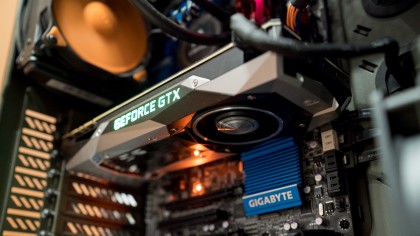
The new king
Nvidia dropped the mic when it announced the Nvidia GTX 1080. The fledgling Pascal part beats the pants off of any previous graphics card Nvidia has made before including the all-mighty Titan X – with twice the level performance no less.
However, beyond the simple raw power, Nvidia has kept most of the details about the GTX 1080 and its new software features under wraps until now. From more efficient overclocking, the smallest transistors Nvidia has ever produced to optimizing VR, there's quite a bit to mull through.
However, here are the seven most important things that will level up your next frag fest.
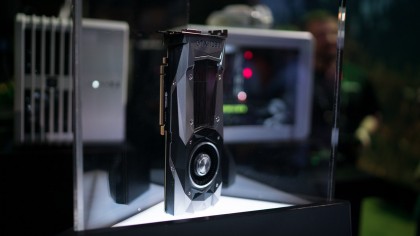
It's way faster than you think
When it comes to computers, going smaller is always better. Tinnier transistors require less power, produce less heat and can be arranged in tighter packets to operate faster. Pascal happens to introduce Nvidia's new smaller 16nm FinFET architecture. Previously, the GPU maker went with a 28nm Maxwell architecture it has used since its 700-series GPUs.
With the new process, Nvidia has managed to squeeze in 7.2 billion transistors into the Nvidia GTX 1080. And while we're talking about specs, the GPU is also equipped with 20 streaming multi-processor (containing 128 cores each), 2560 CUDA cores, 20 geometry units, 160 texture units, 64 ROP units and 8GB of GDDR5X video RAM (operating at 10GBps) to top it all off.
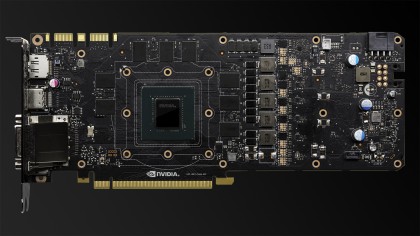
Altogether, these specs allow the 1080 to run at a base clock speed of 1.61GHz, 1.7GHz when boosted and a 2GHz overclock speed.
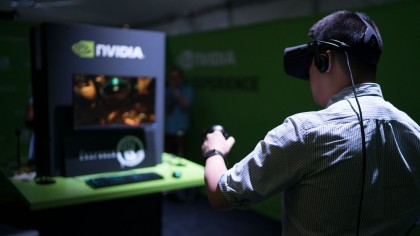
Simultaneous multi-screen projection FTW!
Designed to create a better sense of depth and perspective, simultaneous multi-screen projection (SMP) is Nvidia's solution to improving multi-monitor setups. The problem with most games displayed on multiple screens is they render a 3D game world onto a set of flat planes. In reality, though, you're really only getting one perspective.
Thus far, the only solution gamers could turn to was using multiple GPUs to each render a slightly different picture on each display. This is where SMP comes in to allow you have the same perfect multi-monitor setup using only one graphics card.
SMP's greatest asset is how it can double the performance of virtual reality. Nvidia's Vice President of Engineering Jonah Alben explains that currently VR wastes a ton of resources because it requires PCs to render a fully rectangular picture when users actually see the image through a round hole.
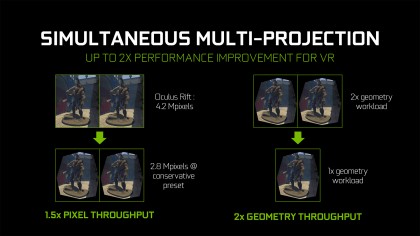
And so the company has introduced lens match shading, which reduces the picture into a pentagon-like shape that mimics the curvature of convex lenses. As a result, the graphics card doesn't render every megapixel to fill out the corners of the frame, which would have simply been cut off anyway.
SMP also works in a similar way for non-VR experiences. In a short The Witness demo, I was shown how I could use the feature to degrade the graphical quality around the edges of the frame in order to get closer to a perfectly smooth 60fps.
The demo was running at a sluggish 45fps with the feature off, but turning on SMP brought it right up to 60fps. It's a smart use of resources because you won't really notice the loss of detail because it's only around the edges.
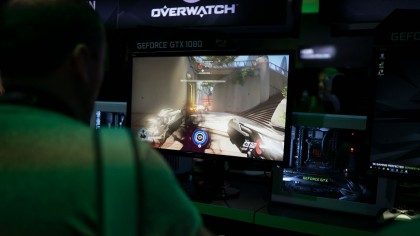
Introducing Fast Sync
Nvidia already introduced G-Sync to help smooth out your frame rate and now it has introduced Fast Sync to help completely eliminate tearing. Whereas V-sync essentially tells the game to slow down and respect the monitor's refresh rate to prevent tearing, Fast Sync places the GPU in a much more active role.
Fast Sync tasks the GPU with checking every rendered frame and chooses which are actually rendered. Despite the involved process, Nvidia claims its triple buffer process reduces latency by 60 milliseconds in Counter Strike GO.
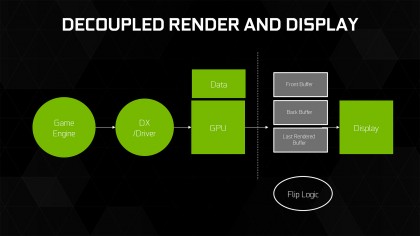
It's also designed to work in tandem with G-Sync, which is better for lower render rates, while Fast Sync is necessary for games with much faster refresh rates.
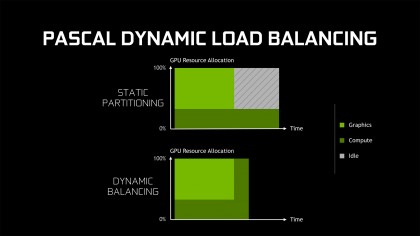
Asynchronous computing
Nvidia has also designed its Pascal architecture to play better with the processor. When completing task, the CPU and GPU traditionally work together in a static partitioning agreement. In this arrangement the GPU focus on a certain pool of calculations and the same goes for the CPU, with neither ever stepping over the boundary line separating them.
The 1080, however, works in a new dynamic mode in which it will call on the CPU to perform more tasks if there's a gap at all and vice-versa. Its' a smarter use of resources to fill what Nvidia calls dead space and it leads to 15-20% increase in frames per second.
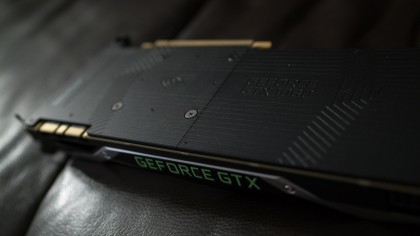
In a side note, Nvidia also enhanced Pascal's preemption abilities with asynchronous time warp. That might sound like word soup, but it's essentially most helpful in VR experiences. The GPU will pre-render images in anticipation of how you turn or move your head. From there it will refresh the display just as you move your head for a less jarring experience.
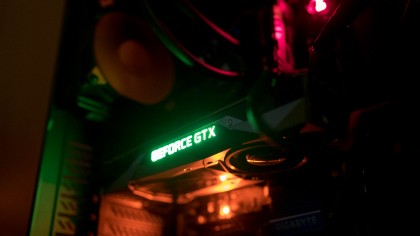
GPU Boost 3.0 + new SLI bridges
Good news for overclockers, Nvidia has made boosting the clockspeed on your GTX 1080 even easier and more efficient. GPU Boost 3.0 modernizes the fixed frequency offset curve with an organic thread that more closely follows the real theoretical curve.
In essence, each GPU has a max clock, which will be easier to reach by adding per voltage frequency offset. And if you're feeling a little antsy about tuning it yourself, GPU Boost 3.0 also adds overclocking scanner support, making it work better with overclocking software.
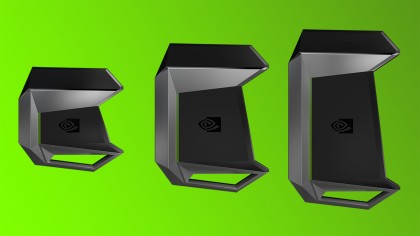
On a smaller note, Nvidia will release new SLI bridges, which will be necessary to game at 4K and 144fps. However, these new hard-form bridges will only work with the Pascal architecture as the GPUs are equipped with faster IO connections.
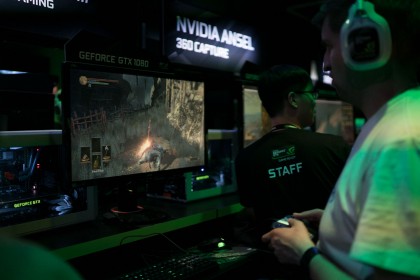
Become the next pro photographer in video games
Though not tied directly to Pascal, Nvidia revealed a new Ansel feature that lets you take your screenshot skills to the next level. Essentially photography in video games, Ansel gives you access to all the picture snapping controls you'd expect out of a real camera. Users will be able to set their focal length, shutter speed, aperture and a host of other customizable, Instagram-inspired shaders.
Ansel also has a leg up on in game screenshotting tools or Fraps, with its ability to take super high-resolution shots. The software tool essentially takes multiple full resolution shots to create one massive image file sort of like the Gigapan or the high-resolution shot mode found on the Olympus Pen-F and OM-D E-M5 Mark II.
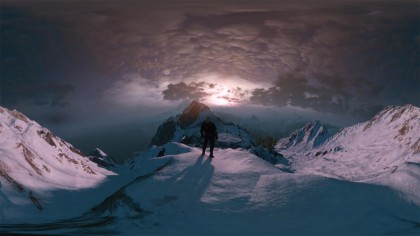
And when we say big we mean a 4.5 giga-pixel image stitched together using 3600 tiles. Alternatively, you could create 360 panoramas consisting of 10 photos.
And after you're all done snapping, you can edit your photos in Lightroom and Photoshop with the full flexibility of RAW images. This is thanks to Ansel outputting everything with EXR capture.

Goodbye reference cards, hello Founders Edition
While previous generations of Nvidia's graphics cards first launched with a reference edition, the GPU maker has decided to launch a new – or really – rebranded version called the Founders Edition.
Instead of setting the starting price for the 1080 and 1070, the Founders edition cards are meant to be premium parts directly from Nvidia. The GPU maker argues it puts a higher price on its own cards because of specials features including vapor chamber cooling and the aluminum shroud.
Nvidia also claims the higher price will allow it to keep producing the Founders Edition throughout the life cycle of the GPUs, whereas the reference cards were being produced at a loss and would eventually disappear.
Of course, if you're looking for more of a bargain, third-party makers will likely produce affordable versions of the GTX 1080 and 1070.

Kevin Lee was a former computing reporter at TechRadar. Kevin is now the SEO Updates Editor at IGN based in New York. He handles all of the best of tech buying guides while also dipping his hand in the entertainment and games evergreen content. Kevin has over eight years of experience in the tech and games publications with previous bylines at Polygon, PC World, and more. Outside of work, Kevin is major movie buff of cult and bad films. He also regularly plays flight & space sim and racing games. IRL he's a fan of archery, axe throwing, and board games.